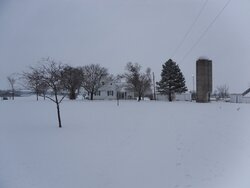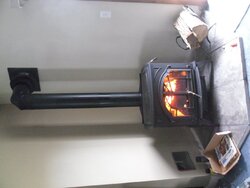Hey, folks. I'm new to the forum and in my 3rd year of wood heating. Although my parents have 2 catalytic VC stoves, we opted to go with a Quad (Isle Royale). It's a corner installation (on a 45) in our living room which has a big 10-ft door into the kitchen/rest of the house: yay for heat transfer and dissipation. That being said, the house is 1886 and had cellulose blown into the walls at some point. Walls are hand-poured single pane with either original weather window or aluminum storm. We have air leaks, drafts, etc., but don't want to use the oil furnace any more than we have to (yikes).
My wood supply has been cured 1-2 years, mixed hardwood species especially ash and red oak. It's always been under roof, first in open stacks with metal roofing to cover and now in a converted corn crib (with southern exposure and prevailing wind).
I've checked out other threads on burn time, reading coals, etc., but I still have some questions.
1) While I understand the secondaries and their advantage: essentially re-burning compounds off-gassed as the wood combusts, is there a duration of secondary ignition I should be aiming for to maximize heat production?
2) While I don't have a stove thermometer (my stove at my previous house had one, to Amazon I go!), I do get the sucker hot! When I pack it full it may "go nuclear" as some of you describe: incredibly hot, fast flame action including secondaries, rapid heat-up with steel expansion sounds. This will last for 1-2 hours, during which the house warms up nicely. Once this has passed, however, the house is cooling off again and the furnace sometimes kicks on! How hot is hot enough? How hot gets to be too hot? It's a cast iron stove and so I understand it can take some heat.
3) I have LOTS of coals. After 1-3 full loads, I have to take several hours to burn the coals down to ash so I can reload the stove. This means the stove is cooling down a touch until I can reload. Suggestions on how to get fewer coals?
4) I have more ashes than I anticipated having as well. When the firebox has 4-6 inches of coals in the bottom, you know you're going to have lots of ashes! My parents' experience with catalytic stoves yielded notably fewer ashes, and I hate to have egg on my face! Ideas on reducing ashes produced?
Any advice would be awesome! Check out the pics if you'd like.
My wood supply has been cured 1-2 years, mixed hardwood species especially ash and red oak. It's always been under roof, first in open stacks with metal roofing to cover and now in a converted corn crib (with southern exposure and prevailing wind).
I've checked out other threads on burn time, reading coals, etc., but I still have some questions.
1) While I understand the secondaries and their advantage: essentially re-burning compounds off-gassed as the wood combusts, is there a duration of secondary ignition I should be aiming for to maximize heat production?
2) While I don't have a stove thermometer (my stove at my previous house had one, to Amazon I go!), I do get the sucker hot! When I pack it full it may "go nuclear" as some of you describe: incredibly hot, fast flame action including secondaries, rapid heat-up with steel expansion sounds. This will last for 1-2 hours, during which the house warms up nicely. Once this has passed, however, the house is cooling off again and the furnace sometimes kicks on! How hot is hot enough? How hot gets to be too hot? It's a cast iron stove and so I understand it can take some heat.
3) I have LOTS of coals. After 1-3 full loads, I have to take several hours to burn the coals down to ash so I can reload the stove. This means the stove is cooling down a touch until I can reload. Suggestions on how to get fewer coals?
4) I have more ashes than I anticipated having as well. When the firebox has 4-6 inches of coals in the bottom, you know you're going to have lots of ashes! My parents' experience with catalytic stoves yielded notably fewer ashes, and I hate to have egg on my face! Ideas on reducing ashes produced?
Any advice would be awesome! Check out the pics if you'd like.



